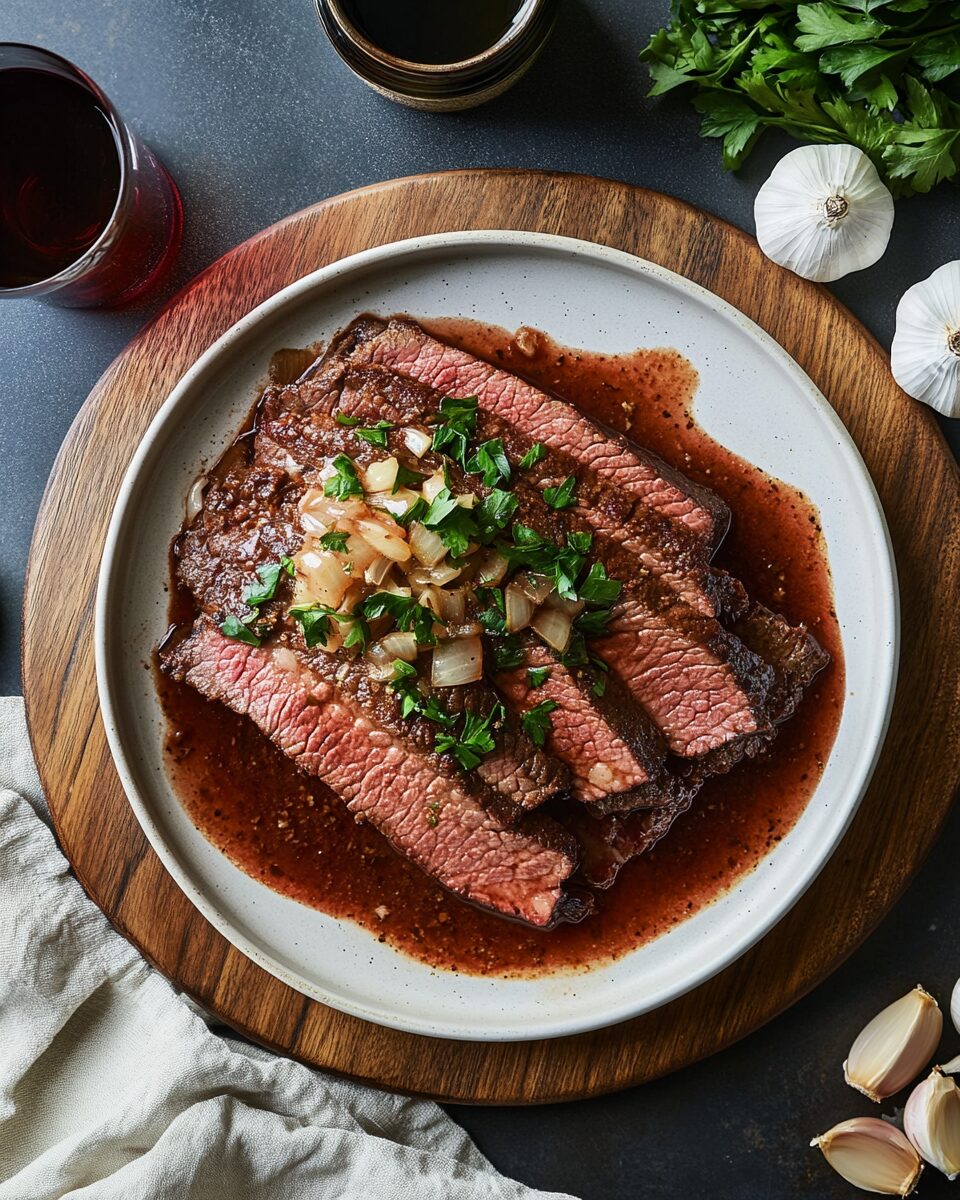A rich and savory dish, Braised Beef Brisket with Garlic and Red Wine is a hearty meal perfect for special occasions or a comforting family dinner. Slow-cooked to perfection, the beef becomes tender and flavorful, soaking up the deep notes of red wine and aromatic garlic.
FULL RECIPE
Ingredients
- 4 pounds beef brisket
- 2 tablespoons olive oil
- 8 cloves garlic, peeled
- 1 large onion, sliced
- 2 cups dry red wine
- 2 cups beef broth
- 2 tablespoons tomato paste
- 1 teaspoon dried thyme
- 1 teaspoon dried rosemary
- 2 bay leaves
- Salt and black pepper to taste
- Fresh parsley, chopped (for garnish)
Directions
- Preheat the oven to 325°F (163°C).
- Season the brisket generously with salt and black pepper.
- Heat the olive oil in a large Dutch oven over medium-high heat.
- Sear the brisket on all sides until browned, about 4-5 minutes per side. Remove and set aside.
- In the same pot, add the garlic cloves and sliced onion. Sauté until softened and fragrant, about 5 minutes.
- Stir in the tomato paste and cook for 1 minute.
- Pour in the red wine and beef broth, scraping up any browned bits from the bottom of the pot.
- Add the thyme, rosemary, and bay leaves. Stir to combine.
- Return the brisket to the pot, cover with a lid, and place in the preheated oven.
- Braise for 3 to 3 ½ hours, or until the brisket is fork-tender.
- Remove the brisket from the pot and let it rest for 10 minutes before slicing.
- Skim any excess fat from the sauce, then simmer the sauce over medium heat to thicken slightly if desired.
- Slice the brisket against the grain, return it to the sauce, and garnish with chopped parsley before serving.
Nutritional Information
- Calories: 450
- Protein: 35g
- Fat: 28g
- Saturated Fat: 10g
- Carbohydrates: 6g
- Fiber: 1g
- Sugar: 2g
- Sodium: 450mg
Flavor Profile of Braised Beef Brisket with Garlic and Red Wine
Braised beef brisket with garlic and red wine offers a rich, deep, and savory flavor. The slow cooking process allows the beef to soak up the bold notes of the red wine, while the garlic infuses the dish with warmth and complexity. Each bite delivers tender, juicy meat with a luxurious sauce that elevates the overall taste.
The Importance of Braising
Braising is essential in this recipe because it breaks down the tough connective tissue in the brisket, transforming it into melt-in-your-mouth tenderness. The combination of dry and moist heat cooking ensures the meat remains juicy while developing a robust flavor throughout.
Choosing the Right Cut of Brisket
Selecting the right brisket is crucial. Look for a cut that has good marbling, as the fat will render during cooking and keep the meat moist. A flat cut works well for uniform slices, while a point cut offers extra richness due to its higher fat content.
Selecting the Best Red Wine
The wine chosen for braising should be dry and full-bodied, like a Cabernet Sauvignon or Merlot. These wines enhance the flavor of the beef without overpowering it. Avoid sweet wines, which can create an unbalanced flavor profile in the final dish.
Benefits of Cooking with Garlic
Garlic does more than add flavor; it provides health benefits such as boosting the immune system and reducing inflammation. In this recipe, garlic mellows and sweetens as it cooks, adding a delicate background note that complements the richness of the beef.
Enhancing Flavor with Fresh Herbs
Thyme, rosemary, and bay leaves infuse the brisket with earthy and aromatic tones. These herbs marry beautifully with the wine and beef, offering layers of flavor that make the sauce irresistible and complex.
Why Tomato Paste is Essential
Tomato paste adds a touch of acidity and sweetness, balancing the bold flavors of the wine and beef. It also helps thicken the sauce slightly, giving it a silky texture that clings to each slice of brisket.
The Role of Beef Broth
Beef broth adds depth and richness to the braising liquid. It supports the beef’s natural flavors, creating a sauce that’s hearty and satisfying without being overly heavy.
Cooking Vessel Considerations
Using a Dutch oven or heavy-bottomed pot is key. These types of cookware retain and distribute heat evenly, ensuring the brisket cooks consistently and develops an excellent sear at the beginning.
Oven Temperature Tips
A low and slow oven temperature, around 325°F (163°C), allows the collagen in the brisket to break down without drying out the meat. This temperature provides the ideal environment for a perfect braise.
Resting the Brisket
Allowing the brisket to rest before slicing is critical. Resting lets the juices redistribute throughout the meat, ensuring each slice is moist and flavorful rather than dry.
How to Slice Brisket Properly
Always slice brisket against the grain. This shortens the muscle fibers, making the meat easier to chew and enhancing tenderness. Look closely at the direction of the grain before slicing for best results.
Skimming and Reducing the Sauce
After braising, skimming excess fat from the sauce improves the flavor and texture. Simmering the sauce after skimming allows it to thicken naturally, concentrating its flavors into a rich, velvety consistency.
Serving Suggestions
This brisket pairs beautifully with mashed potatoes, roasted vegetables, or buttered noodles. The sauce acts as a delicious gravy, tying all the components of the plate together into a comforting and satisfying meal.
Storing and Reheating Leftovers
Braised brisket stores exceptionally well. Refrigerate in an airtight container for up to 4 days or freeze for up to 3 months. Reheat slowly in the oven or stovetop, adding a splash of broth or water if needed to maintain moisture.
Meal Prep and Make-Ahead Tips
This dish is perfect for making ahead. In fact, the flavors deepen after resting overnight. Prepare a day in advance and reheat gently before serving for an even more delicious experience.
Common Mistakes to Avoid
Avoid rushing the searing step, as a good sear develops deep flavor. Also, don’t lift the lid frequently during braising, which releases precious moisture and heat. Finally, be sure not to over-reduce the sauce too early, as it can become too salty.
Substitutions and Variations
For a twist, you can use different wines such as a Syrah or Pinot Noir, or swap the beef broth with a rich mushroom broth for an earthy vegetarian alternative. Adding carrots and mushrooms during the last hour of braising can also enhance the dish.
Cultural Significance of Braised Brisket
Braised brisket is a dish that holds cultural significance in many traditions, especially during Jewish holidays like Passover. It symbolizes nourishment, family togetherness, and celebration, embodying comfort food at its finest.
Conclusion
Braised Beef Brisket with Garlic and Red Wine is a timeless, crowd-pleasing recipe that combines simple ingredients with slow-cooking magic. Its luxurious sauce, tender meat, and deep flavors make it a standout dish for any occasion. By paying attention to technique and ingredient quality, you can create a memorable meal that showcases the art of braising at its best. Whether prepared for a festive gathering or a cozy family dinner, this brisket promises warmth, satisfaction, and culinary joy.






